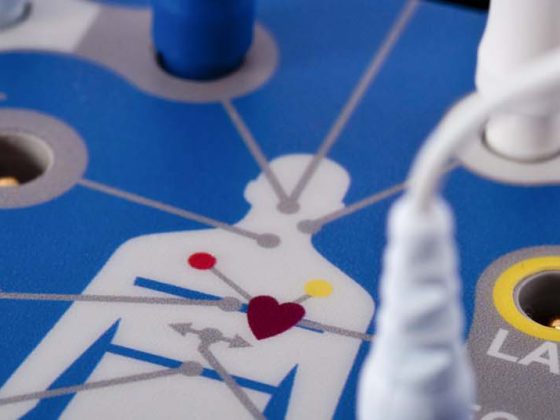Cholesterol management was the subject of discussion at the Prevention Summit at the University Hospital Zurich. The new lipid guidelines from the AHA/ACC are generating a lot of criticism. This is in stark contrast to the new drugs from the class of PCSK9 inhibitors, which are raising great hope, especially in patients with familial hypercholesterolemia. Most recently, we questioned the therapeutic options in the area of HDL and triglycerides.
The new lipid guidelines published by the Americans (AHA/ACC) in November 2013 are also causing a lot of discussion in this country. The type and dosage of statin therapy should be defined on the basis of a (recalculated) risk level, and previous LDL cholesterol target values are relegated to the background in favor of therapeutic potency (50% reduction). Instead of aiming to achieve individually defined LDL target levels depending on baseline risk (outcome-oriented), as is common in Europe, the U.S. guidelines set the statin dose depending on baseline risk (process-oriented): The consequence of this is a lowering of the threshold for prescribing statins in primary prevention. Instead of dosing according to target values, this results in the use of predominantly potent statins, which are expected to reduce LDL cholesterol levels by more than 50%. Four groups would thus benefit from statin therapy: Individuals with clinically manifest cardiovascular disease (under 76 yr), with primary LDL cholesterol elevation (>4.9 mmol/l), with diabetes (40-75 yr) and cardiovascular risk factors, and primary prevention adults (40-75 yr) without these risk factors but with an estimated 10-year risk of ≥7.5% (according to a new scoring system).
Why deviate from the tried and tested path?
Prof. Dr. med. Frank Ruschitzka from the University Hospital Zurich started by explaining the problems and shortcomings of the current U.S. guidelines: “The European way (ESC guidelines), namely going down to the target values, has proven itself, it is a treat-to-target strategy. The American way, on the other hand (AHA/ACC Guidelines), is a dose-adapted one, without target values. However, this strategy has never been tested prospectively and disregards inter-patient variability. It also disregards the causal and linear relationship between LDL cholesterol lowering and reduction of coronary risks. Overall, it’s fair to say that Americans want to be far too aggressive in their approach; in Europe, by contrast, we do it on an individualized basis, and that’s a good thing.”
Using three American presidents as examples, Prof. Ruschitzka reviewed cardiovascular risk stratification according to the ESC-SCORE risk chart. The absolute risk of fatal myocardial infarction or stroke over ten years is:
- Patients at very high risk (old Bill Clinton) at over 10%.
- High risk patients (younger Bill Clinton) at over 5-10%.
- Moderate risk patients (George W. Bush) at over 1-5%.
- Low-risk patients (Barack Obama) at less than 1%.
Patients at very high risk, according to the ESC, are those with a known cardiovascular condition, with type 2 diabetes or type 1 diabetes with microalbuminuria, with very high individual risk factors, and those with chronic kidney disease. “George W. Bush we Europeans would just rather treat with lifestyle interventions, the Americans are taking a more aggressive approach here without need,” the speaker said. “We should thus stay true to our European path.” The new LDL-C target for “old Bill Clintons” is <1.8 mmol/l or ≥50% of baseline.
How often should lipids be tested in practice according to the still valid ESC guidelines? “In any case, before therapeutic lipid lowering, to have a comparative value. The interval until the next measurement, still before therapy, is 1-12 weeks (except in situations where immediate medication becomes necessary, e.g. acute coronary syndrome). After starting lipid lowering, the measurement should be repeated after about eight weeks. After the target value has been reached, an annual check is sufficient,” he said.
PCSK9 inhibitors – What can they do?
PD Dr. med. Isabella Sudano, University Hospital Zurich, gave insight into the study situation of the new “superstatins”, the PCSK9 inhibitors, which offer hopeful prospects especially for patients with familial hypercholesterolemia and with statin intolerance as well as for high-risk patients who do not reach the target values. Outcome studies (phase III) with evolocumab, alirocumab and bococizumab are currently ongoing. It is already clear that inhibition of PCSK9 by monoclonal antibodies is a very promising therapy to reduce LDL-C in patients with familial hypercholesterolemia (heterozygous and homozygous with reduced LDL receptor activity) and also in those with nonfamilial hypercholesterolemia. The inhibitors are extremely effective (both together with current therapy and in monotherapy) and are also well tolerated by patients with statin intolerance (as well as high-risk patients) [1–4]. The LDL is lowered stably and over a longer period of time (at least over one year). “The mode of application is a new one: The active ingredient is injected subcutaneously every two or four weeks,” she said. “The safety profile is amazing: no significant side effects have been identified in the phase II and III studies to date. But what impresses me most are the data in familial hypercholesterolemia. In the heterozygous form, PCSK9 inhibitors led to a 40-60 percent reduction in LDL (and also non-HDL-C, apoB and lipoprotein[a]). In homozygous forms with reduced activity of the receptors, a reduction of the above parameters was also achieved – only in homozygous patients, who have no receptors, LDL could not be reduced under therapy (in contrast to the remaining factors). Tolerability is consistently good.”
ODYSSEY Study Program at ESC 2014
Among other things, Dr. Sudano was referring to data presented at this year’s ESC conference in Barcelona (ODYSEEY program): ODYSSEY FH I & II are two studies [5] testing the effect of alirocumab in patients with heterozygous familial hypercholesterolemia and poor LDL-C control on current lipid therapy (sometimes statins). Since this inherited condition causes extremely high LDL-C levels and thus increased risks for atherosclerosis and cardiovascular disease, new therapeutic approaches are highly welcome. Currently, statin therapies are used at the maximum tolerated dose (or combinations e.g. with ezetimibe) – however, baseline levels of LDL-C still remain relatively high in most cases. In the trials, either alirocumab or placebo was added to the existing therapy: Alirocumab reduced LDL-C by a highly significant average of 48.8 and 48.7% since baseline, respectively, compared with increases of 9.1 and 2.8% with placebo (p<0.0001). Only about 40% each required a dose increase at week twelve (from 75 to 150 mg every two weeks) to reach the target value of <1.81 mmol/l. The reductions persisted until the 52nd week.
A long-term study [6] with 2431 participants (high cholesterol, high cardiovascular risk, or heterozygous familial hypercholesterolemia) belonging to the ODYSSEY program also showed very good efficacy after 24 weeks (81 vs. 9% of patients with very high and high risk achieved LDL-C target values). Alirocumab patients achieved an average LDL-C reduction of 61% since baseline, while placebo patients (on statin or combination therapy) shared a 0.8% increase (p<0.0001). Second, the safety data at week 52 were surprising: there were no more adverse events with verum (78.6%) than with placebo (80.6%).
“LDL reduction, by the way, is limited: once all PCSK9 are bound, LDL is not reduced further,” Dr. Sudano explained.
Is HDL really “dead” therapeutically?
“The therapeutic approach of specifically increasing HDL in patients already taking a statin has unfortunately not been successful to date,” Prof. Ruschitzka noted at the start of the lecture series. Should Prof. Dr. med. Thomas F. Lüscher, University Hospital Zurich, provide evidence to the contrary? After all, his presentation was entitled “HDL and Triglycerides:
What’s new?” As was soon to become apparent, there was in fact hardly any positive news from this area.
“In principle, HDL does everything we want it to do, but as a molecule it is many times more complex than LDL. Its biological effect changes in the course of the disease: as soon as we are ill, the positive effect of HDL no longer works,” the speaker said.
Studies have shown that low HDL cholesterol is associated with increased cardiovascular risk despite intensified statin therapy [7]. Consequently, how can it be increased for prevention? One is through lifestyle measures, and the other is through medications and HDL mimetics. Unfortunately, various drug approaches have proven largely ineffective:
AIM-HIGH study: this study tested nicotinic acid in combination with a statin to increase HDL cholesterol levels. Although this actually increased, the addition of niacin had no significant effect on the event rate. Subsequent nicotinic acid combination in unequal numbers of patients also did not meet the primary endpoint (HPS2-THRIVE). The risk of myopathy actually increased.
ILLUMINATE trial: torcetrapib (in combination with a statin vs. statin alone) also caused a large increase in HDL (+72%) with a simultaneous decrease in LDL (-25%) in over 15000 participants, but after significantly more deaths and cardiovascular events occurred with the combination, the trial had to be stopped in December 2006.
Dal-VESSEL study: d alcetrapib, an agent in the same class as torcetrapib that also increased HDL, was not significantly different from placebo (blood pressure, endothelial function) in the primary endpoint.
DEFINE study: anacetrapib, again a CETP inhibitor like the above two agents, significantly lowers LDL (-39.8%), while also significantly increasing HDL (+138.1%). The subsequent REVEAL trial, whose outcome data are due to be released soon, is now investigating whether the drug can prevent serious coronary complications (i.e., the clinical benefit).
According to the latest data, the HDL mimetic CER-001 also shows no effect in coronary artherosclerosis [8].
Triglycerides
Finally, Prof. Lüscher spoke about triglycerides: “Triglycerides are associated with cardiovascular events and pancreatitis. So there is a good reason to lower them. We do this using fibrates, but they have only a modest effect on cardiovascular events. Nevertheless, genetic mutations suggest that triglycerides are causally associated with cardiovascular events. Thus, here we must wait for definitive data from new specific drugs.”
Source: Prevention Summit, September 11, 2014, Zurich
Literature:
- Stein EA, et al: Effect of the proprotein convertase subtilisin/kexin 9 monoclonal antibody, AMG 145, in homozygous familial hypercholesterolemia. Circulation 2013 Nov 5; 128(19): 2113-2120.
- Stroes E, et al: Anti-PCSK9 antibody effectively lowers cholesterol in patients with statin intolerance: the GAUSS-2 randomized, placebo-controlled phase 3 clinical trial of evolocumab. J Am Coll Cardiol 2014 Jun 17; 63(23): 2541-2548.
- Robinson JG, et al: Effect of evolocumab or ezetimibe added to moderate- or high-intensity statin therapy on LDL-C lowering in patients with hypercholesterolemia: the LAPLACE-2 randomized clinical trial. JAMA 2014 May 14; 311(18): 1870-1882.
- Blom DJ, et al: A 52-week placebo-controlled trial of evolocumab in hyperlipidemia. N Engl J Med 2014 May 8; 370(19): 1809-1819.
- Farnier M, et al: Efficacy and safety of alirocumab in patients with heterozygous familial hypercholesterolaemia not adequately controlled with current lipid-lowering therapy: results of ODYSSEY FH I and FH II studies. ESC Hot Line Session II.
- Robinson JG, et al: Long-term safety, tolerability and efficacy of alirocumab versus placebo in high cardiovascular risk patients: first results from the ODYSSEY LONG TERM study in 2,341 patients. ESC Hot Lines Session II.
- Barter P, et al: HDL cholesterol, very low levels of LDL cholesterol, and cardiovascular events. N Engl J Med 2007 Sep 27; 357(13): 1301-1310.
- Tardif JC, et al: Effects of the high-density lipoprotein mimetic agent CER-001 on coronary atherosclerosis in patients with acute coronary syndromes: a randomized trial. Eur Heart J 2014 Apr 29. [Epub ahead of print].
CARDIOVASC 2014; 13(5): 22-24












